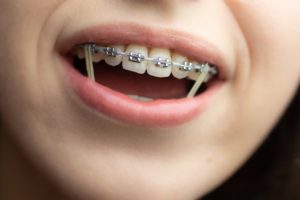
With over 4 million Americans wearing braces, their popularity in correcting crooked teeth is apparent. Though some individuals only need braces, others require additions such as rubber bands. Why do some people need rubber bands? Will you or your child need them if either of you get braces? Here’s everything you need to know about wearing rubber bands on braces.
How Braces Work
Braces feature brackets attached to your teeth that have a wire running along them. The brackets and wire work in unison to press against your teeth and move them over a period of time to straighten them and close gaps. While braces generally have a high rate of success, their effectiveness varies depending on the person and how closely they follow their orthodontist’s instructions.
How Rubber Bands Work with Your Braces
Rubber bands, or elastics, increase the force applied to specific areas of the mouth. They hook on to the brackets on your braces and can be positioned in a variety of ways to make teeth move in a way braces can’t on their own. When or if a patient needs to use rubber bands depends on their treatment plan. Elastics can be used to correct issues such as overbites, underbites, open bites, and crossbites.
Types of Rubber Bands
Rubber bands are categorized by the amount of force exerted, size of the elastic, the type of material they’re made from, and how they’re meant to be used. Here’s a more in depth look in to the four categories of elastics:
- The three levels of force are light, medium, and heavy and are measured in ounces or grams. The amount of force exertion varies by manufacturer.
- Elastic size is measured in diameter and depends on how far it needs to stretch to get the job done.
- Rubber bands are made from either latex or synthetic material. While latex is highly flexible and inexpensive to make, synthetic bands are the better choice for people with a latex allergy. Research also suggests that latex elastics may exert more stable force over a period of time.
- The five main uses for rubber bands include:
- Class I rubber bands are positioned horizontally and link brackets on one of your jaws to help close gaps between your teeth.
- Class II rubber bands connect the teeth of the upper jaw to the molars of the lower jaw to correct an overbite.
- Class III rubber bands connect the teeth of the lower jaw to the molars of the upper jaw and can correct an underbite.
- Cross rubber bands connect the teeth on the upper and lower jaw and usually cross over the front teeth to correct a crossbite.
- Vertical rubber bands link the teeth of the upper jaw to the teeth below them to correct an open bite.
Though rubber bands can be a hassle, they work with braces to improve the look and function of the wearer’s teeth. By following the dentist’s instructions, braces wearers will soon be on their way to a straighter, more beautiful smile!
About the Practice
Contrary to popular belief, braces aren’t just for kids. At Huntington Orthodontics, Dr. Justyna Balicka and her talented Huntington team treat patients of all ages in a safe, warm, boutique-style atmosphere the whole family is sure to love. They take a more personal approach to oral health care by giving each patient their undivided attention and working together to craft the ideal treatment plan. To learn more about how braces and rubber bands can help straighten your teeth and improve the look of your smile, visit our website or call our office at (631) 759-8834.

